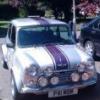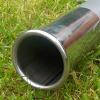I'm certainly no welding expert, in fact I only started learning myself a few weeks ago. But I have tried to explain a few of the basic welding terms as I understand them below:
Spot Welding : The method that is generally used in the factory to weld panels together on a mini where the edges/lips of two or more panels are sandwiched together on top of one another. (obvious places on a mini include amongst others; along the top of the outer sills, between the wings and the A panels, along the rear bumper lip between the rear valance and boot floor). It involves passing a current between two points above one another on a single spot, using a specialist "
Spot Welder" machine, that performs only that task and therefore cannot be performed using a mig welder.
Plug Welding:The technique that is often used to replicate spot welds using a mig welder. Involves drilling regularly spaced holes along the edge of the upper most panel, then effectively filling/plugging the holes up with weld and thereby welding the uppermost panel to the one beneath.
Seam welding:Long continuous welds along the edge of two panels.
Pulse welding:Short sections of seam welding with gaps in between, often used to avoid the panel distortion caused by the heat of long continuous seam welds.
Edited by AVV IT, 04 August 2011 - 09:21 AM.

















